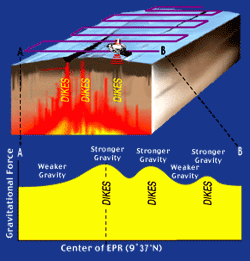|
Hot Topics: Biogeography of deep-sea hydrothermal vent faunas We all know that if you drop a ball, it will fall towards the ground. We also know that the higher you are when you drop the ball, the faster and harder it will hit the Earth. Balls drop because of gravity -- the force of the Earth's gravity field. Actually all objects pull on (or exert a force on) each other. The reason that the ball falls towards the ground is that the Earth is very much bigger than anything else nearby it in space, and therefore Earth’s gravity is much greater than that of any other object nearby, even the Moon. The reason that objects dropped from a great distance above the ground hit the ground harder is that they are accelerated (their speed changes with time) because of gravity. The more time they spend falling the faster they go. Dikes are more compact and dense than lava flows, so the force of gravity is very slightly greater above zones where numerous dikes, or swarms as geologists call them, are concentrated. The gravimeter mounted in Alvin can measure these small changes in gravity and map out the pattern of shallow dikes under the axis. During Cruise 2, scientists are using a gravimeter, a sensitive instrument that determines the force of gravity, mounted in the sphere of Alvin, to measure very small changes in Earth’s gravity at the mid-ocean ridge on the East Pacific Rise crest near 9° 37’N. Using data collected by the instruments on Alvin, it is hoped that we can determine the pattern of gravity anomalies, or changes from what the gravity should be at this latitude, that are associated with the different types of rocks underneath the East Pacific Rise crest. The two main types of rocks in this area are lava and dikes. Because the volcanic terrain in this area has many collapse features, scientists think that there is a considerable volume of the shallow ocean crust that is not solid rock, rather it comprises lava tubes and collapse features that are filled with sea water. The hypothesis that we are testing is whether small changes and different patterns in the gravity anomalies measured by Alvin can be used to see where the feeder dikes, which contain denser rocks, are beneath the ridge axis at a fast spreading center. If we can find this out it will help scientists better understand how the ocean crust is formed by volcanic eruptions.
|
|
© 2010 Dive and Discover™. Dive and Discover™ is a registered trademark of Woods Hole Oceanographic Institution
|
|
